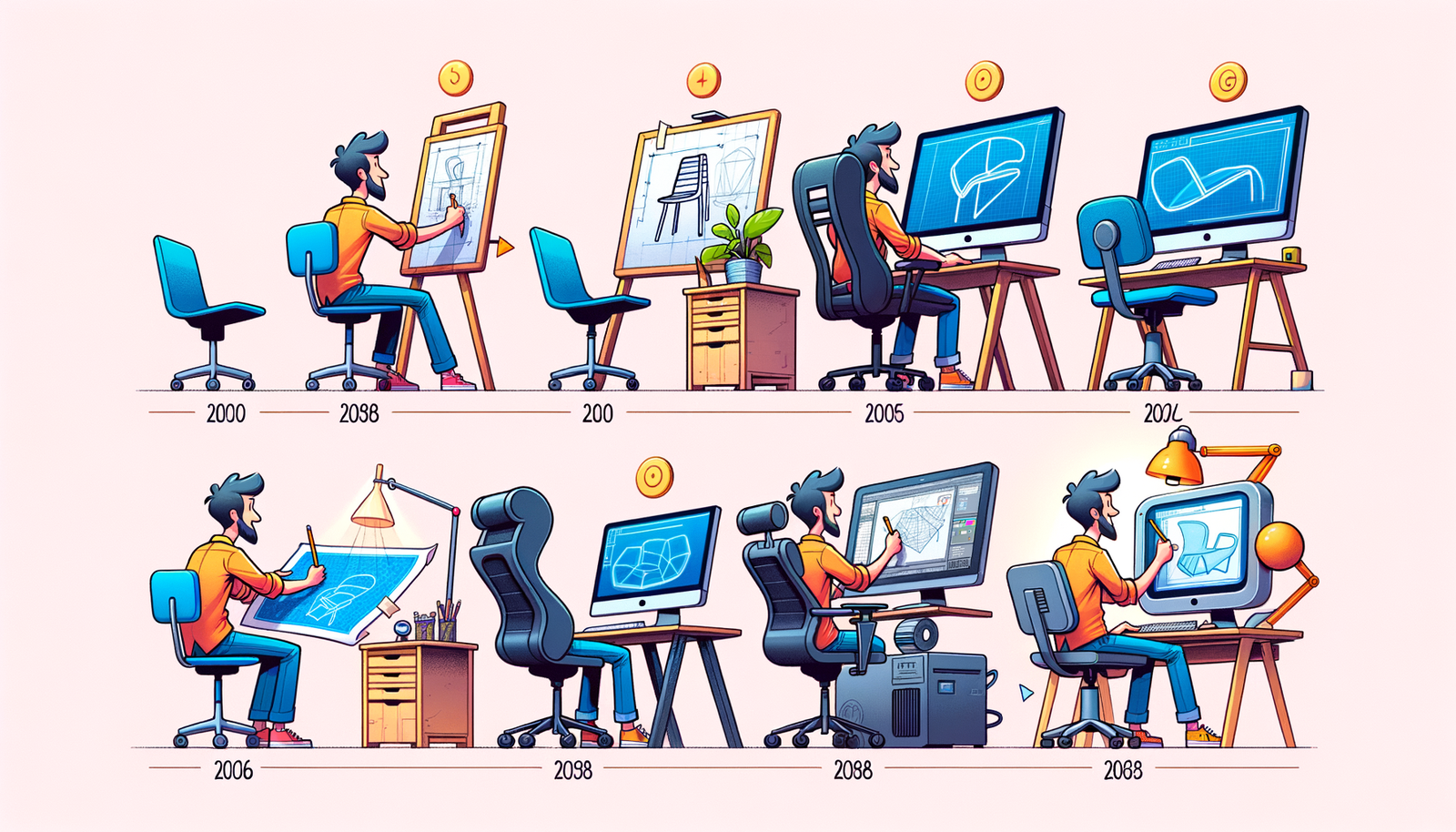Your Cart is Empty
Customer Testimonials
-
"Great customer service. The folks at Novedge were super helpful in navigating a somewhat complicated order including software upgrades and serial numbers in various stages of inactivity. They were friendly and helpful throughout the process.."
Ruben Ruckmark
"Quick & very helpful. We have been using Novedge for years and are very happy with their quick service when we need to make a purchase and excellent support resolving any issues."
Will Woodson
"Scott is the best. He reminds me about subscriptions dates, guides me in the correct direction for updates. He always responds promptly to me. He is literally the reason I continue to work with Novedge and will do so in the future."
Edward Mchugh
"Calvin Lok is “the man”. After my purchase of Sketchup 2021, he called me and provided step-by-step instructions to ease me through difficulties I was having with the setup of my new software."
Mike Borzage
Design Software History: The Evolution of Design Software and Its Impact on the Furniture Industry
October 04, 2024 6 min read


Introduction
In today's rapidly evolving furniture industry, design software has become an indispensable tool that revolutionizes the way furniture is conceptualized, designed, and brought to market. The integration of advanced software solutions has not only streamlined the design process but also fostered innovation, enabling designers to push the boundaries of creativity and functionality. Before the advent of digital software, furniture design was a meticulous and labor-intensive process, heavily reliant on manual drafting and physical prototyping. This traditional approach often resulted in extended lead times and limited the ability to make swift alterations in response to market trends or client feedback. The historical context of furniture design tools reflects a journey from hand-drawn sketches and scale models to the sophisticated computer-aided design (CAD) systems we see today. Pioneering figures like Ivan Sutherland, who developed the Sketchpad system in 1963, laid the groundwork for computer graphics and interactive interfaces, influencing future CAD development. Companies such as Autodesk, founded by John Walker in 1982, played a crucial role in democratizing design software with the release of AutoCAD, which became a staple in various design industries, including furniture. As the industry progressed, key players emerged, introducing specialized tools tailored to the unique needs of furniture designers. Software like SketchUp, initially developed by @Last Software and later acquired by Google and then Trimble Navigation, provided an accessible platform for three-dimensional modeling. Similarly, Autodesk's Fusion 360 offered integrated CAD, CAM, and CAE features, transforming how designers approached complex furniture projects. These milestones not only enhanced design efficiency but also opened new avenues for customization and manufacturing, setting the stage for the current era where technology and design are inextricably linked.Early Design Tools and Their Limitations
Before the digital revolution, furniture designers relied heavily on traditional tools such as drafting boards, T-squares, compasses, and rulers to bring their visions to life. This hands-on approach required a high degree of precision and skill, as every dimension and detail had to be meticulously calculated and drawn by hand. The use of materials like vellum and blueprint paper was standard, and the process of creating detailed design plans was often protracted and painstaking. Designers like Charles and Ray Eames, renowned for their innovative furniture in the mid-20th century, exemplified the meticulous craftsmanship required in this era. However, the manual nature of these tools introduced significant limitations, including susceptibility to human error, difficulties in modifying designs, and challenges in visualizing complex three-dimensional structures. One of the primary challenges faced by designers in the pre-software era was the time-consuming processes inherent in manual drafting. Any alteration necessitated redrawing significant portions of the plan, which not only consumed valuable time but also increased the risk of introducing inconsistencies. Additionally, accurately conveying three-dimensional concepts on two-dimensional media was inherently challenging, often leading to misinterpretations during the manufacturing phase. This difficulty was compounded when collaborating with clients or other stakeholders who might struggle to fully grasp the envisioned design from flat drawings. To summarize, the limitations of traditional tools included:- Inaccuracy and Human Error: Manual calculations and drawings were prone to mistakes, affecting the quality of the final product.
- Lack of Flexibility: Modifying designs was cumbersome, often requiring redrawing entire plans.
- Time Constraints: Lengthy drafting processes delayed project timelines and increased costs.
- Communication Barriers: Difficulty in visualizing and conveying complex designs to clients and manufacturers.
The Rise of Specialized Furniture Design Software
The evolution of design software in the furniture industry accelerated with the emergence of specialized tools tailored to meet the specific needs of furniture designers. Recognizing the limitations of general-purpose CAD software, developers began creating platforms that offered features and functionalities catering directly to furniture design. One of the notable innovations in this space was the introduction of parametric design, allowing designers to define models with parameters that could be easily adjusted, resulting in dynamic and flexible design processes. This shift enabled rapid prototyping and customization, significantly reducing time-to-market. Software like SketchUp, initially released in 2000 by @Last Software, revolutionized 3D modeling with its user-friendly interface and intuitive push-pull tool for extruding surfaces. Its acquisition by Google in 2006 and later by Trimble Navigation in 2012 expanded its capabilities and integration with other technologies. SketchUp became a favorite among furniture designers for its ease of use and the ability to quickly create and modify complex shapes. Similarly, Autodesk's Fusion 360, launched in 2013, integrated CAD, CAM, and CAE into a single cloud-based platform. Fusion 360 provided furniture designers with advanced tools such as sculpting, parametric modeling, and comprehensive material libraries, enhancing both creativity and efficiency. These specialized software solutions introduced features that significantly improved the design workflow. The inclusion of extensive material libraries allowed designers to apply realistic textures and finishes to their models, aiding in visualization and client presentations. Advanced rendering capabilities enabled the creation of photorealistic images, facilitating better communication of design intent. Furthermore, the integration of simulation and analysis tools helped in assessing the structural integrity and functionality of furniture pieces before physical prototyping. Key features that catered specifically to furniture designers included:- Parametric Design: Allowing for easy adjustments of dimensions and proportions, enabling rapid customization.
- Material Libraries: Providing access to a wide range of materials and finishes for realistic modeling.
- Advanced Rendering: Generating high-quality visualizations and animations to showcase designs.
- Collaboration Tools: Facilitating teamwork through cloud-based platforms and shared workspaces.
The Future of Design Software in the Furniture Industry
As technology continues to evolve at an unprecedented pace, the furniture industry stands on the cusp of a new era characterized by immersive technologies and intelligent systems. One of the most significant trends is the incorporation of virtual reality (VR) and augmented reality (AR) into the design process. VR allows designers and clients to experience furniture designs in a fully immersive 3D environment, facilitating a deeper understanding of scale, proportion, and aesthetics before any physical prototype is created. Companies like Oculus, acquired by Facebook (now Meta Platforms), and HTC with their Vive platform, have made VR technology more accessible, enabling its integration into design workflows. Similarly, AR applications, such as those developed by Apple with ARKit and Google with ARCore, allow users to overlay virtual furniture models onto real-world environments using smartphones or tablets. This technology has been harnessed by furniture retailers like IKEA with their IKEA Place app, enhancing customer engagement and aiding in purchase decisions. The potential for additive manufacturing, commonly known as 3D printing, represents another frontier for the furniture industry. Integration of design software with advanced manufacturing technologies allows for the creation of complex, customized pieces that were previously impossible or cost-prohibitive using traditional manufacturing methods. Pioneers like Janne Kyttanen have demonstrated the possibilities of 3D-printed furniture, pushing the boundaries of design and material usage. Software platforms are increasingly incorporating tools to optimize designs for additive manufacturing, ensuring structural integrity while minimizing material usage. Companies like Stratasys and Ultimaker are advancing 3D printing technologies, making them more viable for large-scale furniture production. Looking ahead, the incorporation of evolving technologies such asAlso in Design News

Cinema 4D Tip: Weight Manager Workflow for Fast, Stable Character Skinning
January 06, 2026 2 min read
Read More
Revit Tip: Purge Unused Families and Types to Optimize Revit Models
January 06, 2026 2 min read
Read MoreSubscribe
Sign up to get the latest on sales, new releases and more …



